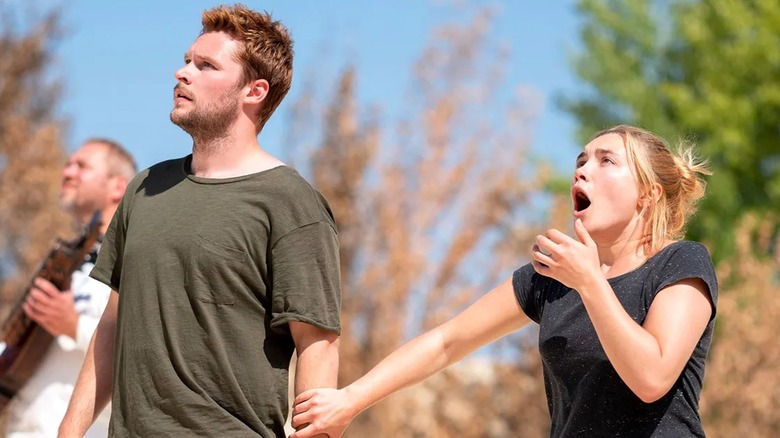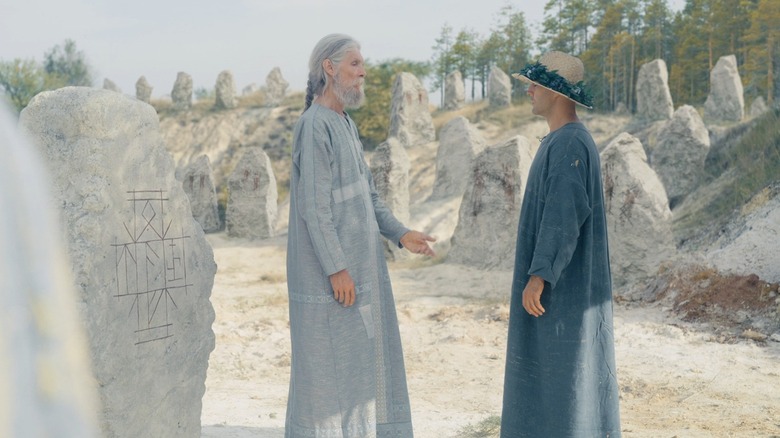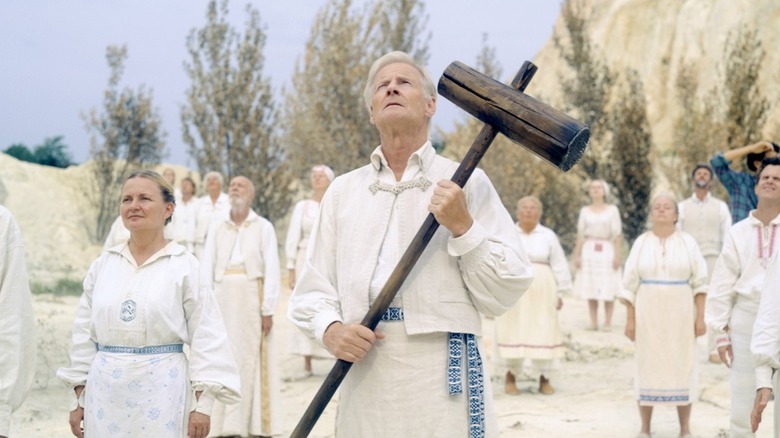Midsommar's VFX Team Only Had Three Weeks To Create Its Sickest Scene
This post contains spoilers for "Midsommar."
The arrival at Hårga village in Ari Aster's "Midsommar" seems harmonious at first — perhaps, a bit too harmonious, with everyone donning stark white and plastered smiles till the illusion of sanctity shatters. This happens halfway through the film after the first feast ends, where the oldest members of the commune wilfully jump off a cliff, completing the Ättestupa ritual in excessively violent ways. When the male elder is still alive after his jump, his legs bent and cracked due to the impact, the villagers mock his pain and smash his head in over and over with a massive mallet. The visceral shock of the scene is intensified by the anxiety of what might happen after, as it is clear that the Ättestupa is just the beginning of a fever dream designed to torment and disorient.
How was this visually shocking scene accomplished? The finer details of the Ättestupa scene were achieved with a mix of practical and CG effects, and the latter was implemented within an extremely narrow window before the film's release. These effects were spearheaded by the creative studio The-Artery, which was responsible for generating CG facial animation and gore elements (among other creative enhancements throughout the film). Vico Sharabani, founder of The-Artery, who also served as a VFX Supervisor for "Midsommar," spoke to Vulture in 2019 about the challenging nature of designing the CG treatment for the Ättestupa scene, as it included several close-up shots of a skull being smashed by a weapon. Here's what Sharabani had to say about the incredible creative feat, which was accomplished within a tight turnaround time.
It was all-hands-on-deck for the Midsommar VFX team
Sharabani explained that the VFX team at The-Artery had a turnaround time of "less than three weeks" despite being tasked with designing a scene that would traditionally demand a lengthy preparation period:
"For 'Midsommar', it was a huge challenge to design and craft a CG treatment that would depict the physical devastation suffered by a pair of sacrificial offerings. We were brought on with a little less than three weeks before the theatrical release deadline. We created 30 complicated CG shots — skulls being smashed by sledgehammers, faces and limbs, torsos shattering against rocks after being thrown from cliffs above, and blood treatments. All amazingly complex treatments within an incredibly short window of time."
Although the film's production team was well aware that this task required more time, they had no choice but to reach out to The-Artery with "the release date looming," which naturally meant an all-hands-on-deck approach until the project was wrapped up. While the VFX elements lent the scene its gut-wrenching aura and appeal, while introducing seamlessness between the CG and prosthetic aspects, the Ättestupa scene would have been impossible without Iván Pohárnok, the film's prosthetic makeup designer, whose Hungary-based company Filmefex designed all the corpses featured throughout "Midsommar." Filmefex has also designed corpses and human remains in films like "Blade Runner 2049" and 2006's "Taxidermia," with the latter being a startling, meaningful showcase of Pohárnok's skilfully grotesque vision.
Pohárnok also spoke to Vulture about the nitty-gritty of the Ättestupa scene, while stating that he "instantly fell in love with" the "twisted, weird idea" that was Aster's "Midsommar."
The prosthetics team for Midsommar aimed to shock and horrify
"Midsommar" features several offscreen deaths that are violent and disturbing, but the ones that are witnessed by the film's characters are equally unsettling, depending on the context. While the Ättestupa skull-smashing is the entry point to the hellish underbelly of a seemingly joyful commune (which is actually a cult), the other deaths solidify this ugly reality, where bodies are seen stuffed into the soil or put on display in the barn after being blood-eagled. Pohárnok and his team crafted these corpses, where the cast of the actor's body is taken and used as a mold to create a hyperrealistic silicone rubber dummy. Digital scans were also used in some cases, which were then tweaked to achieve the desired result.
According to Pohárnok, the bodies designed for the Ättestupa ritual scene demanded more meticulous artistry than usual, as the mechanics of creating prosthetics for the character who survives the fall with his legs broken was tricky to execute. The problem was solved by digging a hole for the actor, Björn Andrésen, so that only his head stuck out, with a dummy body being strategically placed to create the bloody, twisted bones and mangled muscles.
But what about the unforgettable skull-smashing? Pohárnok explained that his team made a collapsable head that could implode from within with the help of a pneumatic cylinder. The head could also be reset with the push of a button:
"It worked beautifully. We just pressed the button and everything popped back into the original, pristine face."
This allowed Aster several opportunities to reset the prop head until perfection was captured. The cumulative dread of the scene was subsequently etched on the faces of the film's characters — and our own.


